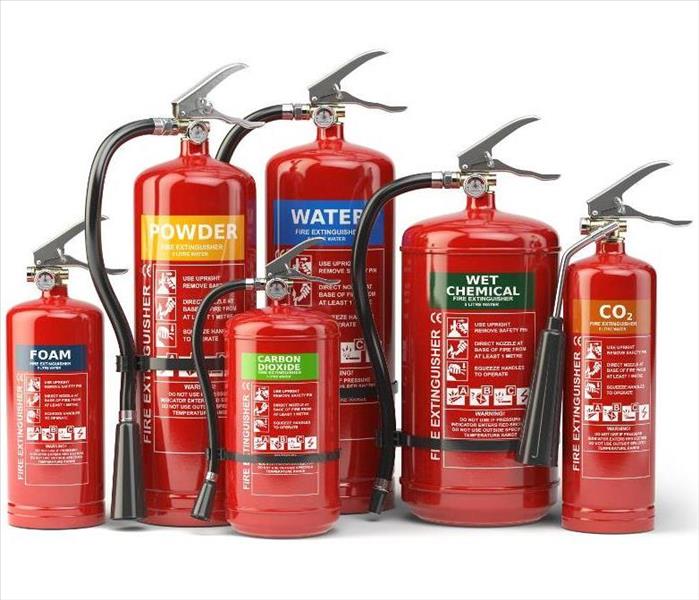Fire Extinguishers - What You Need To Know
1/16/2019 (Permalink)
If you were given five seconds to answer the following questions, could you?
- Where are the fire extinguishers in your home or office?
- How do you operate those fire extinguishers?
- What type of extinguisher(s) are they?
In the event of a fire you’ll need to know the answers to all of these questions and you’ll need to know them FAST. Fires can consume a building in a matter of minutes, the faster you’re able to create a plan and react, the better.
The Fire Triangle, which is technically a tetrahedron because it has four elements, explains what is necessary for a fire to exist. A fire needs oxygen to sustain combustion, heat to raise the material to its ignition temperature, fuel to support the combustion and a chemical reaction between these three elements to sustain itself. Removing any one of the four elements will extinguish the fire.
Placement
A fire extinguisher should be placed on each level of your home or office building, and especially in places where fires are more likely to occur, like the kitchen and garage. They should be easily accessible and never covered or surrounded.
Types of Fires
We’ll start by classifying the different types of fires. The source or cause of the fire and its location determine what must be used to extinguish it.
CLASS A: contain ordinary combustibles such as wood, paper, cloth, rubber and many plastics.
CLASS B: are in flammable liquids like gasoline, petroleum greases, tars, oils, oil-based paints, solvents and alcohols. Class B fires also include flammable gases such as propane and butane. These do no include fires involving cooking oils and grease.
CLASS C: involve energized electrical equipment like computers, servers, motors, transformers and appliances. Remove the power and the Class C fire becomes a different class of fire.
CLASS D: are fires in combustible metals like magnesium, titanium, zirconium, sodium, lithium, and potassium.
CLASS K: fires in cooking oils and greases such as animal and vegetable fats.
Types of Fire Extinguishers
Water and Foam: takes away the element of heat in the fire triangle. Foam agents also separate the oxygen from the other elements.
- Water Extinguishers are for Class A only – they should not be used on Class B or C fires. The discharge steam could spread the flammable liquid in a Class B fire or could create a shock hazard on a Class C fire.
Carbon Dioxide: take away the oxygen element of the fire triangle and also by removing the heat with a very cold discharge.
- Carbon dioxide can be used on Class B & C fires. They are usually ineffective on Class A fires.
Dry Chemical: extinguish the fire primarily by interrupting the chemical reaction of the fire triangle.
- The most commonly used type of fire extinguisher is the multipurpose dry chemical because it is effective on Class A, B and C fires. This agent also works by creating a barrier between the oxygen element and the fuel element on Class A.
Wet Chemical: a new agent that extinguishes the fire by removing the heat of the fire triangle and prevents re-ignition by creating a barrier between the oxygen and fuel elements.
- Wet chemical extinguishers or Class K extinguishers were designed for modern, high efficiency deep fat fryers in commercial cooking operations.
Clean Agent: Halogenated or Clean Agent extinguishers include the halon agents as well as the newer less ozone depleting halocarbon agents. They extinguish the fire by interrupting the chemical reaction and/or removing heat from the fire triangle.
- Clean agent extinguishers are effective on Class A, B and C fires.
Dry Powder: similar to dry chemical except they extinguish the fire by separating the fuel from the oxygen element or by removing the heat element of the fire triangle.
- Dry Powder extinguishers are for Class D or combustible metals fires only
Water Mist: take away the heat element of the fire triangle. They are an alternative to the clean agent extinguishers where contamination is a concern.
- Water mist extinguishers are primarily for Class A fires, although they are safe for use on Class C as well.
Use of A Fire Extinguisher
Remembering how to use any fire extinguisher is simple if you can remember the acronym P.A.S.S:
- Pull the pin
- Aim the nozzle or hose at the base of the fire from the recommended distance
- Squeeze the operating lever to discharge the fire extinguishing agent
- Sweep the nozzle or hose from side to side until the fire is out
Buying Guide
When purchasing a fire extinguisher, it is important to check the classification listed on the packaging. Manufacturers make it easier on consumers by labeling their products based on the type of fires they’re formulated to extinguish. Most home improvement stores carry products that carry Class A through Class C. Consider the types of materials within the are you're placing the extinguisher, in kitchens it is best practice to have one classified for grease fires as well as multi-purpose.

 24/7 Emergency Service
24/7 Emergency Service
